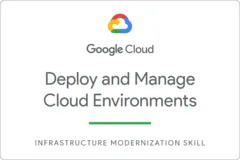
Deploy and Manage Cloud Environments with Google Cloud 
Learn the basics of Deploy and Manage Cloud Environments with Google Cloud ▼
ADVERTISEMENT
Course Feature
![]() Cost:
Cost:
Free
![]() Provider:
Provider:
ThaiMOOC
![]() Certificate:
Certificate:
Free Certification
![]() Language:
Language:
English
![]() Start Date:
Start Date:
On-Demand
Course Overview
❗The content presented here is sourced directly from ThaiMOOC platform. For comprehensive course details, including enrollment information, simply click on the 'Go to class' link on our website.
Updated in [May 19th, 2023]
This course provides an overview of how to deploy and manage cloud environments with Google Cloud. Participants will learn how to deploy and manage a containerized application using Google Kubernetes Engine and kubectl, launch a VM-based application using Cloud Deployment Manager, and then monitor and stress the application. Additionally, participants will learn how to deploy continuous delivery pipelines using Google Kubernetes Engine and Spinnaker, create and control access to multiple VPC networks, and configure and use Cloud Monitoring to troubleshoot breaks in applications. Upon completion of the course, participants will receive a skill badge issued by Google Cloud in recognition of their proficiency with Google Cloud products and services.
[Applications]
Upon completion of the Deploy and Manage Cloud Environments with Google Cloud course, learners can apply their knowledge to deploy and manage containerized applications using Google Kubernetes Engine and kubectl, launch a VM-based application using Cloud Deployment Manager, deploy continuous delivery pipelines using Google Kubernetes Engine and Spinnaker, create and control access to multiple VPC networks, and configure and use Cloud Monitoring to troubleshoot breaks in applications. Learners can also earn a skill badge by completing the Deploy and Manage Cloud Environments with Google Cloud quest and final assessment challenge lab.
[Career Paths]
1. Cloud Engineer: Cloud Engineers are responsible for designing, deploying, and managing cloud-based systems. They must be knowledgeable in cloud computing technologies, such as Google Cloud Platform, Amazon Web Services, and Microsoft Azure. They must also be able to develop and maintain cloud-based applications, as well as troubleshoot any issues that arise. As cloud computing continues to grow in popularity, the demand for Cloud Engineers is expected to increase.
2. DevOps Engineer: DevOps Engineers are responsible for automating the development, testing, and deployment of applications. They must be knowledgeable in cloud computing technologies, such as Google Cloud Platform, Amazon Web Services, and Microsoft Azure. They must also be able to develop and maintain cloud-based applications, as well as troubleshoot any issues that arise. As cloud computing continues to grow in popularity, the demand for DevOps Engineers is expected to increase.
3. Cloud Security Engineer: Cloud Security Engineers are responsible for designing, deploying, and managing cloud-based security systems. They must be knowledgeable in cloud computing technologies, such as Google Cloud Platform, Amazon Web Services, and Microsoft Azure. They must also be able to develop and maintain cloud-based security applications, as well as troubleshoot any security issues that arise. As cloud computing continues to grow in popularity, the demand for Cloud Security Engineers is expected to increase.
4. Cloud Architect: Cloud Architects are responsible for designing, deploying, and managing cloud-based architectures. They must be knowledgeable in cloud computing technologies, such as Google Cloud Platform, Amazon Web Services, and Microsoft Azure. They must also be able to develop and maintain cloud-based architectures, as well as troubleshoot any issues that arise. As cloud computing continues to grow in popularity, the demand for Cloud Architects is expected to increase.
[Education Paths]
1. Bachelor of Science in Computer Science: This degree path focuses on the fundamentals of computer science, such as programming, software engineering, and computer architecture. It also covers topics such as artificial intelligence, machine learning, and data science. This degree path is ideal for those looking to develop a strong foundation in computer science and pursue a career in the field.
2. Master of Science in Cloud Computing: This degree path focuses on the development and management of cloud computing systems. It covers topics such as cloud architecture, cloud security, cloud storage, and cloud networking. This degree path is ideal for those looking to specialize in cloud computing and pursue a career in the field.
3. Master of Science in Data Science: This degree path focuses on the analysis and interpretation of large datasets. It covers topics such as data mining, machine learning, and data visualization. This degree path is ideal for those looking to specialize in data science and pursue a career in the field.
4. Master of Science in Artificial Intelligence: This degree path focuses on the development of intelligent systems. It covers topics such as natural language processing, computer vision, and robotics. This degree path is ideal for those looking to specialize in artificial intelligence and pursue a career in the field.
The demand for professionals with expertise in cloud computing, data science, and artificial intelligence is growing rapidly. As businesses move to the cloud, they need professionals who can help them deploy and manage cloud environments. Data science and artificial intelligence are also becoming increasingly important as businesses look to leverage data to gain insights and make better decisions. As such, these degree paths are becoming increasingly popular and are expected to continue to grow in demand in the coming years.
Course Syllabus
Orchestrating the Cloud with Kubernetes
In this lab you will learn how to provision a complete Kubernetes cluster using Google Container Engine; deploy and manage Docker containers using kubectl; and break an application into microservices using Kubernetesâ Deployments and Services.Continuous Delivery Pipelines with Spinnaker and Kubernetes Engine
Create a Kubernetes Engine cluster, deploy an application, and use Spinnaker to continuously deploy the application when changes are made to the application.Multiple VPC Networks
In this lab, you create several VPC networks and VM instances and test connectivity across networks.Troubleshooting Workloads on GKE for Site Reliability Engineers
The Cloud Operations Sandbox is intended to make it easy for you to deploy and run a non-trivial application that lets you explore the Google Cloud Platform services, particularly the Cloud Operations (formerly Stackdriver) product suite.Deploy and Manage Cloud Environments with Google Cloud: Challenge Lab
This challenge lab tests your skills and knowledge from the labs in the Cloud Architecture quest. You should be familiar with the content of labs before attempting this lab.Course Provider

Provider ThaiMOOC's Stats at AZClass
Discussion and Reviews
0.0 (Based on 0 reviews)
Explore Similar Online Courses

Positive Psychiatry and Mental Health

Cloud Healthcare API

Python for Informatics: Exploring Information

Social Network Analysis

Introduction to Systematic Review and Meta-Analysis

The Analytics Edge

DCO042 - Python For Informatics

Causal Diagrams: Draw Your Assumptions Before Your Conclusions

Whole genome sequencing of bacterial genomes - tools and applications

Serverless Data Processing with Dataflow: Develop Pipelines

Serverless Data Processing with Dataflow: Foundations


Start your review of Deploy and Manage Cloud Environments with Google Cloud